I want to convert RAW image data (RGGB) to sRGB image. There are many specialized ways to do this but to first understand the basics, I've implemented some easy alogrithms like debayering by resolution-reduction. My current pipeline is:
- Rescale the u16 input data by blacklevel and whitelevel
- Apply white balance coefficents
- Debayer with size reduction, average for G: g=((g0+g1)/2)
- Calculate pseudo-inverse for D65 illuminant XYZ_TO_CAM (from Adobe DNG)
- Convert debayered RGB data to XYZ by CAM_TO_XYZ
- Convert XYZ to D65 sRGB (matrix taken from Bruce Lindbloom)
- Apply gamma correction (simple routine for now, should be replaced by sRGB gamma)
- Rescale from [minval..maxval] to [0..1] and convert f32 to u16
- Save as tiff
The problem is that if I skip the white balance coefficent multiplication (or just replace them by 1.0) the output image already looks acceptable. If I apply the coefficents (taken from AsShot in DNG) the output has a huge color cast. And I'm not sure if I have to multiply by coef or 1/coef.
The first image is the result of the pipeline with wb_coefs set to 1.0.
The second image is the result with the "correct" wb_coefs.
What is wrong in my pipeline?
Additional question:
- I'm not sure about the rescaling process. Do I've to rescale into [0..1] after every step or is it enough to rescale during u16 conversion as final stage?
Full code:
macro_rules! max {
($x: expr) => ($x);
($x: expr, $($z: expr),+) => {{
let y = max!($($z),*);
if $x > y {
$x
} else {
y
}
}}
}
macro_rules! min {
($x: expr) => ($x);
($x: expr, $($z: expr),+) => {{
let y = min!($($z),*);
if $x < y {
$x
} else {
y
}
}}
}
/// sRGB D65
const XYZD65_TO_SRGB: [[f32; 3]; 4] = [
[3.2404542, -1.5371385, -0.4985314],
[-0.9692660, 1.8760108, 0.0415560],
[0.0556434, -0.2040259, 1.0572252],
[0.0, 0.0, 0.0],
];
// buf: RAW image data
fn to_srgb(buf: &Vec<u16>, width: usize, height: usize) {
let w = width / 2;
let h = height / 2;
let blacklevel: [u16; 4] = [511, 511, 511, 511];
let whitelevel: [u16; 4] = [12735, 12735, 12735, 12735];
let xyz2cam_d65: [[i32; 3]; 4] = [[6722, -635, -963], [-4287, 12460, 2028], [-908, 2162, 5668], [0, 0, 0]];
let cam2xyz = convert_matrix::<4>(xyz2cam_d65);
eprintln!("CAM_TO_XYZ: {:?}", cam2xyz);
// from DNG
// As Shot Neutral: 0.518481 1 0.545842
//let wb_coef = [1.0/0.518481, 1.0, 1.0, 1.0/0.545842];
//let wb_coef = [0.518481, 1.0, 1.0, 0.545842];
let wb_coef = [1.0, 1.0, 1.0, 1.0];
// b/w level correction, rescale, debayer
let mut rgb = vec![0.0_f32; width / 2 * height / 2 * 3];
for row in 0..h {
for col in 0..w {
let r0 = buf[(row * 2 + 0) * width + (col * 2) + 0];
let g0 = buf[(row * 2 + 0) * width + (col * 2) + 1];
let g1 = buf[(row * 2 + 1) * width + (col * 2) + 0];
let b0 = buf[(row * 2 + 1) * width + (col * 2) + 1];
let r0 = ((r0.saturating_sub(blacklevel[0])) as f32 / (whitelevel[0] - blacklevel[0]) as f32) * wb_coef[0];
let g0 = ((g0.saturating_sub(blacklevel[1])) as f32 / (whitelevel[1] - blacklevel[1]) as f32) * wb_coef[1];
let g1 = ((g1.saturating_sub(blacklevel[2])) as f32 / (whitelevel[2] - blacklevel[2]) as f32) * wb_coef[2];
let b0 = ((b0.saturating_sub(blacklevel[3])) as f32 / (whitelevel[3] - blacklevel[3]) as f32) * wb_coef[3];
rgb[row * w * 3 + (col * 3) + 0] = r0;
rgb[row * w * 3 + (col * 3) + 1] = (g0 + g1) / 2.0;
rgb[row * w * 3 + (col * 3) + 2] = b0;
}
}
// Convert to XYZ by CAM_TO_XYZ from D65 illuminant
let mut xyz = vec![0.0_f32; w * h * 3];
for row in 0..h {
for col in 0..w {
let r = rgb[row * w * 3 + (col * 3) + 0];
let g = rgb[row * w * 3 + (col * 3) + 1];
let b = rgb[row * w * 3 + (col * 3) + 2];
xyz[row * w * 3 + (col * 3) + 0] = cam2xyz[0][0] * r + cam2xyz[0][1] * g + cam2xyz[0][2] * b;
xyz[row * w * 3 + (col * 3) + 1] = cam2xyz[1][0] * r + cam2xyz[1][1] * g + cam2xyz[1][2] * b;
xyz[row * w * 3 + (col * 3) + 2] = cam2xyz[2][0] * r + cam2xyz[2][1] * g + cam2xyz[2][2] * b;
}
}
// Track min/max value for rescaling/clipping
let mut maxval = 1.0;
let mut minval = 0.0;
// Convert to sRGB from XYZ
let mut srgb = vec![0.0; w * h * 3];
for row in 0..h {
for col in 0..w {
let r = xyz[row * w * 3 + (col * 3) + 0] as f32;
let g = xyz[row * w * 3 + (col * 3) + 1] as f32;
let b = xyz[row * w * 3 + (col * 3) + 2] as f32;
srgb[row * w * 3 + (col * 3) + 0] = XYZD65_TO_SRGB[0][0] * r + XYZD65_TO_SRGB[0][1] * g + XYZD65_TO_SRGB[0][2] * b;
srgb[row * w * 3 + (col * 3) + 1] = XYZD65_TO_SRGB[1][0] * r + XYZD65_TO_SRGB[1][1] * g + XYZD65_TO_SRGB[1][2] * b;
srgb[row * w * 3 + (col * 3) + 2] = XYZD65_TO_SRGB[2][0] * r + XYZD65_TO_SRGB[2][1] * g + XYZD65_TO_SRGB[2][2] * b;
let r = srgb[row * w * 3 + (col * 3) + 0];
let g = srgb[row * w * 3 + (col * 3) + 1];
let b = srgb[row * w * 3 + (col * 3) + 2];
maxval = max!(maxval, r, g, b);
minval = min!(minval, r, g, b);
}
}
gamma_corr(&mut srgb, w, h, 2.2);
let mut output = vec![0_u16; w * h * 3];
for row in 0..h {
for col in 0..w {
let r = srgb[row * w * 3 + (col * 3) + 0];
let g = srgb[row * w * 3 + (col * 3) + 1];
let b = srgb[row * w * 3 + (col * 3) + 2];
output[row * w * 3 + (col * 3) + 0] = (clip(r, minval, maxval) * (u16::MAX as f32)) as u16;
output[row * w * 3 + (col * 3) + 1] = (clip(g, minval, maxval) * (u16::MAX as f32)) as u16;
output[row * w * 3 + (col * 3) + 2] = (clip(b, minval, maxval) * (u16::MAX as f32)) as u16;
}
}
let img = DynamicImage::ImageRgb16(ImageBuffer::from_raw(w as u32, h as u32, output).unwrap());
img.save_with_format("/tmp/test.tif", image::ImageFormat::Tiff).unwrap();
}
fn pseudoinverse<const N: usize>(matrix: [[f32; 3]; N]) -> [[f32; 3]; N] {
let mut result: [[f32; 3]; N] = [Default::default(); N];
let mut work: [[f32; 6]; 3] = [Default::default(); 3];
let mut num: f32 = 0.0;
for i in 0..3 {
for j in 0..6 {
work[i][j] = if j == i + 3 { 1.0 } else { 0.0 };
}
for j in 0..3 {
for k in 0..N {
work[i][j] += matrix[k][i] * matrix[k][j];
}
}
}
for i in 0..3 {
num = work[i][i];
for j in 0..6 {
work[i][j] /= num;
}
for k in 0..3 {
if k == i {
continue;
}
num = work[k][i];
for j in 0..6 {
work[k][j] -= work[i][j] * num;
}
}
}
for i in 0..N {
for j in 0..3 {
result[i][j] = 0.0;
for k in 0..3 {
result[i][j] += work[j][k + 3] * matrix[i][k];
}
}
}
result
}
fn convert_matrix<const N: usize>(adobe_xyz_to_cam: [[i32; 3]; N]) -> [[f32; N]; 3] {
let mut xyz_to_cam: [[f32; 3]; N] = [[0.0; 3]; N];
let mut cam_to_xyz: [[f32; N]; 3] = [[0.0; N]; 3];
for i in 0..N {
for j in 0..3 {
xyz_to_cam[i][j] = adobe_xyz_to_cam[i][j] as f32 / 10000.0;
}
}
eprintln!("XYZ_TO_CAM: {:?}", xyz_to_cam);
let inverse = pseudoinverse::<N>(xyz_to_cam);
for i in 0..3 {
for j in 0..N {
cam_to_xyz[i][j] = inverse[j][i];
}
}
cam_to_xyz
}
fn clip(v: f32, minval: f32, maxval: f32) -> f32 {
(v + minval.abs()) / (maxval + minval.abs())
}
// https://kosinix.github.io/raster/docs/src/raster/filter.rs.html#339-359
fn gamma_corr(rgb: &mut Vec<f32>, w: usize, h: usize, gamma: f32) {
for row in 0..h {
for col in 0..w {
let r = rgb[row * w * 3 + (col * 3) + 0];
let g = rgb[row * w * 3 + (col * 3) + 1];
let b = rgb[row * w * 3 + (col * 3) + 2];
rgb[row * w * 3 + (col * 3) + 0] = r.powf(1.0 / gamma);
rgb[row * w * 3 + (col * 3) + 1] = g.powf(1.0 / gamma);
rgb[row * w * 3 + (col * 3) + 2] = b.powf(1.0 / gamma);
}
}
}
The DNG for this example can be found at: https://chaospixel.com/pub/misc/dng/sample.dng (~40 MiB).




